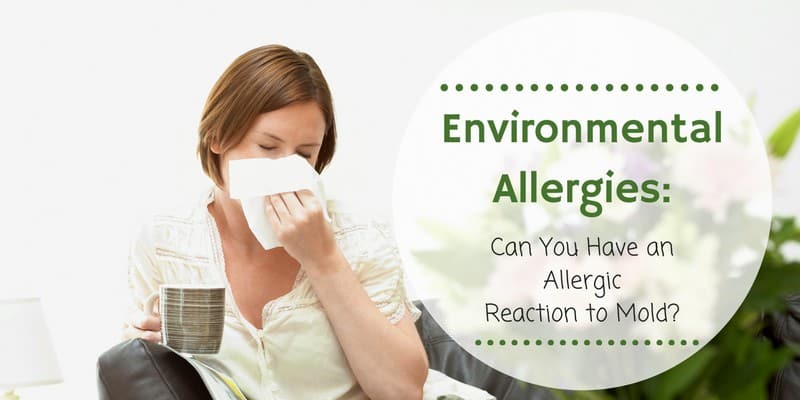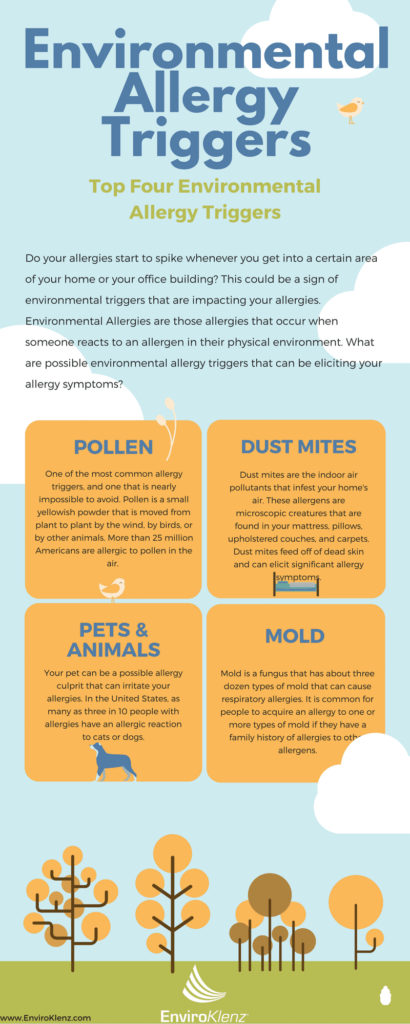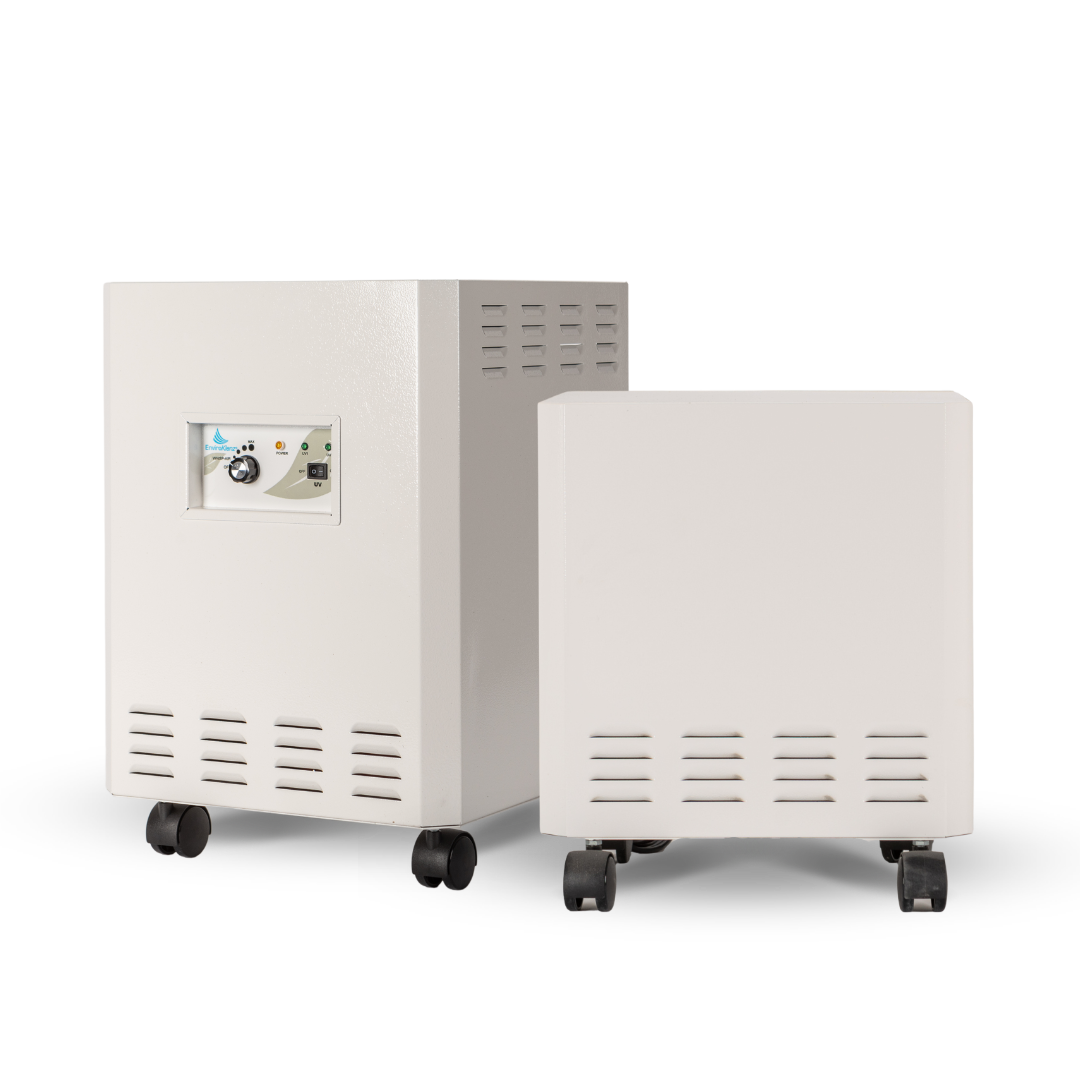Have you ever experienced a bout of uncontrollable sinus symptoms such as a runny nose, itchy eyes, and watery eyes? For the vast majority of people, they have experienced allergies once in their lives and know when their allergies have been triggered. Allergies are a dominant cause of illness in the United States, with as many as 50 million people suffering from this condition. There are numerous amounts of potential allergies (http://acaai.org/allergies/types) that one can suffer from including food, skin, dust, insect sting, pet, eye, drug, allergic rhinitis, latex, mold, sinus, and cockroach allergies. With this long list of potential allergy triggers, it can be difficult to determine exactly the key culprit behind your pesky allergy symptoms. Environmental triggers can play a major role in the onset of your allergies, and learning what these possible triggers are can help you defend yourself from allergy culprits.
Environmental Allergy Triggers
Do your allergies start to spike whenever you get into a certain area of your home or your office building? This could be a sign of environmental triggers that are impacting your allergies. Environmental Allergies are those allergies that occur when someone reacts to an allergen in their physical environment. What are possible environmental allergy triggers that can be eliciting your allergy symptoms?
Pollen
One of the most common allergy triggers, and one that is nearly impossible to avoid. Pollen is a small yellowish powder that is moved from plant to plant by the wind, by birds or by other animals. The spread of pollen can lead to the misery of many seasonal allergies sufferers that begin to feel the symptoms of allergies commence. More than 25 million Americans are allergic to pollen in the air and can suffer from sinus and respiratory tract problems.
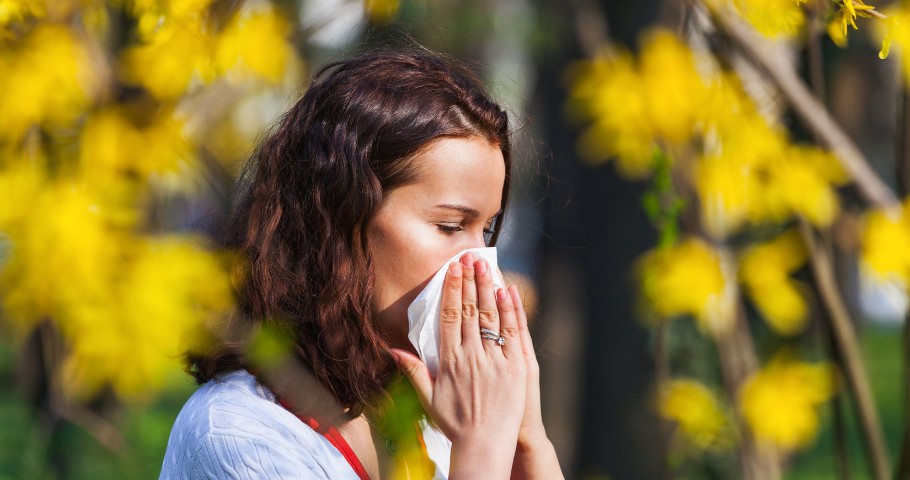
Dust Mites
Dust mites are the indoor air pollutants that infest your home’s air. These allergens are microscopic creatures that are found in everyone’s mattresses, pillows, upholstered couches, and carpets. Unlike bed bugs that bite, dust mites actually feed off of dead skin, so they can manifest in areas where a lot of dead skin tends to gather such as your bed. This allergen can elicit significant issues such as nasal congestion, sinus infections, headaches and sometimes even difficulty sleeping. Good home hygiene can help to minimize dust mites in your home and reduce the potential exposure to this allergen.
Pets and Animals
Your pet can be a possible allergy culprit that can irritate your allergies. In the United States, as many as 3 in 10 people with allergies have allergic reactions to cats and dogs. Bathing your pet frequently, maybe once a week can help to limit the exposure to allergens. Allergens can also be found in your pet’s saliva and urine, so when they are giving you licks it could be affecting your allergies as well.
Mold
Mold is a fungus that has about three dozen types of mold that can cause respiratory allergies. It is common for people to acquire an allergy to one or more types of mold if they have a family history of allergies to other allergens such as pollen or animal dander. Indoor exposure to molds can result in allergy symptoms all year round and leave you to wonder what the cause of this misery is from. Mold growth happens when moisture levels are high in your home and condensation has built up on your walls or windows or after a flood or plumbing leak. As mold grows in your home it will start to release allergens (mold spores that are released from the mold), irritants, and other toxic substances.
Types of Mold That Affects Your Allergies
Alternaria
Certain types of mold are known allergy-eliciting fungus’s that begin the onset of allergy symptoms for many people. The most common types of molds that affect allergies are Alternaria, Aspergillus, Cladosporium, and Penicillium. If you are allergic to mold and you breathe in the spores of one of these allergy-eliciting mold, chances are your immune system will start to go crazy. Your body thinks that the mold is dangerous, even though it may not be and your body will release antibodies that then will release allergy symptoms.
Alternaria is a commonly recognized allergy causing fungus, with its spores found from spring to late fall in most temperate areas. This type of mold is made of about 40 to 50 species that can potentially trigger allergies. Studies have shown that as many as 70% of mold-allergic patients have reacted to skin tests of Alternaria. Asthma is also another cause of Alternaria spores in many people, so if your asthma has begun to act up you may find that this form of mold could be living in your personal environment.
Aspergillus
Allergic Bronchopulmonary Aspergillosis (ABPA) is an allergic reaction to a fungus known as Aspergillus. This condition results in your immune system to overreact to the Aspergillus mold that comes into contact with your airways and can lead to lung inflammation. About 10% of people with cystic fibrosis or asthma will experience an allergic reaction to this type of mold, and ABPA is calculated to occur in about 2% of all asthmatic and 2-15% of patients with cystic fibrosis.
Cladosporium
Cladosporium is a mold that is commonly found in your home and can hide within the carpets, wallpaper, window sills, fabrics, walls, wood surfaces, cabinets, floors and HVAC vent covers of your home. When you are exposed to this mold, Cladosporium can have different effects on people depending on the health standing of that person and their reaction level to the mold. When Cladosporium is growing inside, colonies will feed on moist surfaces, and infest the indoor air with mold spores. When you inhale these spores it can trigger an allergic reaction in people with mold allergies.
Penicillium
Penicillium is a mold that can lead to nasal allergies and asthma in certain people. It can be an airborne threat, with many found in the air and dust of residences and public buildings. This mold due to its allergenic nature as a respiratory irritant can contribute to the development of chronic rhinitis, sinus infection, and pneumonia.
Mold Allergy Symptoms to Look Out For
Mold allergies have similar symptoms to those of other upper respiratory allergies. Mold allergy symptoms can vary from person to person, and severity can depend based on the person. Symptoms of a mold allergy include;
- Sneezing
- Runny and stuffy nose
- A cough and postnasal drip
- Itchy eyes, nose, and throat
- Watery eyes
- Dry skin
Natural Mold Allergy Remedy
Mold spores are the main culprits that elicit mold-allergies in most individuals. It is the mold spores in the air that find their way into our air passageways and can irritate our passages causing allergy symptoms. These mold spores can not only lead to a potential allergy attack but can also lead to an array of other health problems. Therefore, you want to remove these spores from your personal environment and furnishings to help you breathe better and lessen your chances of experiencing mold-related allergies.
The EnviroKlenz Mobile UV Model is perfectly designed to remove mold spores and other small particulates from the environment. The EnviroKlenz UV Mobile System contains a dual air filtration with a patented earth mineral air cartridge to remove chemicals & odors and a hospital grade HEPA filter to remove fine particulates from your air. This air purification system also contains ultraviolet germicidal radiation (UVC lights) that remove airborne particulates and allergens and inhibit the growth of captured microorganisms such as bacteria, mold, and viruses. The allergens and microorganisms such as mold spores get trapped by the HEPA filter, allowing the UVC lights above the HEPA filter to shine on top of the filter killing all these allergens and mold spores with a high efficiency of kill.
Mold in your personal environment can release mold spores into your air leading to mold-induced allergies. Finding ways to mitigate this toxic mold from your home can help to reduce your allergy symptoms and help to improve your overall health.
Our Recommended Solution…
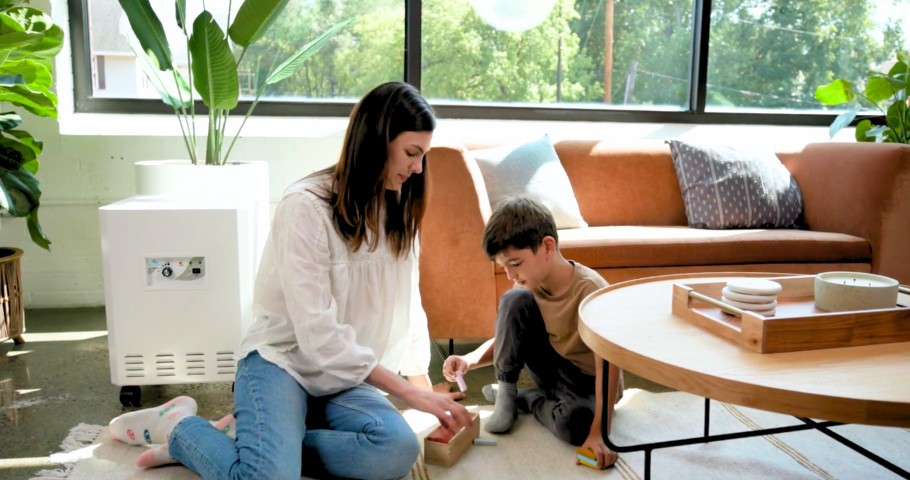
The EnviroKlenz Mobile UV System offers indoor air protection from potentially harmful mold spores that could be in your home’s air. Do you have mold in your home? The EnviroKlenz UV System can help! This system utilizes Ultraviolet Germicidal Radiation (UVC lights) to trap and kill mold spores that are in your indoor air. Breathe easier with this air purification system in your home!
- Two-Stage Filtration, With Patented Technology & a Certified Hospital-Grade HEPA Filter for Ultimate Protection!
- Ultraviolet Germicidal Radiation (UVC) to Kill Mold Spores, Bacteria, & Viruses With a High Efficiency of Kill
- Air Cartridge That Works to Eliminate a Broad Spectrum of Chemicals & Odors- With Up to a 6 Month Life!
We are confident that our EnviroKlenz Technology will drastically reduce the odors in your home, if it doesn’t live up to your expectations, we will issue a full refund within 30 days of your purchase!
Click below to buy NOW!
Hear What People Are Saying About Us…
Similar Blogs You May Also Be Interested In…
Allergic Reaction to Mold- Signs of Mold in Your Home
“Every day we are surrounded by allergens in our environment, some that may impact us and our health more severely than others. Our home’s can be a breeding ground for unwarranted allergens as the indoor air collects the allergens found in your home. One of the biggest home allergens that we must combat is the dreaded and hard to expel mold.”
Mold Allergies: Aspergillus Mold an Allergy Trigger
“One household mold that has been known to elicit symptoms of allergies when in your home is Aspergillus mold. Not only does this mold cause allergy symptoms but it can also cause a range of other potential health concerns such as Aspergillosis and Allergic Bronchopulmonary Aspergillosis (ABPA).”
What Causes Mold Allergies in Dogs?
“What kind of allergens could be causing your dog to have these allergies and how do we help our furry friends overcome this allergy? Different types of mold in your home could be a prominent component in your home perpetuating your dog’s allergies.”
8 Ways to Treat Mold Allergies in Your Home
“When you are faced with intense mold allergies in your home there comes a point where you must implement action to remove the source of the issue from your home completely. Following this preventive guide to treating your mold allergies in your home can help to drastically improve your mold allergies and help prevent allergic reactions to mold.”








